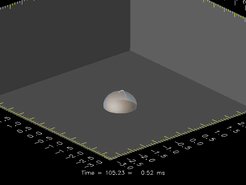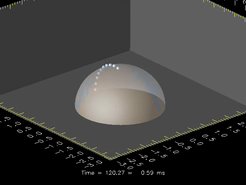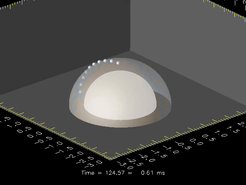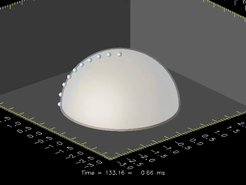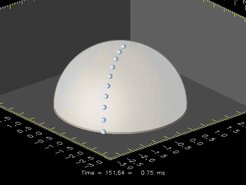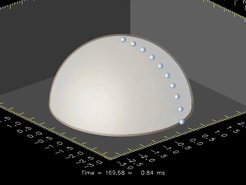Gravitational collapse
Gravitational collapse to a rotating black hole
Collapse with excision: horizons
This visualization of a computer simulation shows the gravitational collapse of a neutron star to a rotating black hole. Such a collapse is one of the strongest sources of electromagnetic and gravitational radiation. But only a millionth part of the system energy is emitted as gravitational waves, so the computations have to be very accurate, and the numerical problem is quite challenging. Furthermore, in order to make good predictions of possible gravitational wave signals, the simulation has to be carried out on a large spacial region, as the gravitational waves take their so-called asymptotic form - how we can detect them on earth - only far away from the source. With the numerical method used here it was possible for the first time to compute the gravitational radiation of such an event with an all three-dimensional simulation.
The images show the evolution of the event horizon and the apparent horizon of the black hole originating from the collapse. The grey swelling hemisphere is the event horizon which is the "surface" of the black hole. Nothing, not even light, can escape from inside the event horizon. With the small test volumes the mass and the spin of the black hole - its fundamental properties - can be determined.
Soon after the formation of the event horizon, the apparent horizon appears (light grey). This is - at a given time step - the boundary between regions where outgoing light rays can still escape to infinity and where they are trapped in the black hole. But a light ray that ecapes at a given instant can be caught at a later time step, when more matter has fallen into the black hole. The event horizon, in contrast, is independent of the time step and the observer: It separates the last light rays that will ever escape from the inside of the black hole. Thus the apparent horizon always is within the event horizon until they coincide at the end of the dynamic process of formation.
In order to compute the event horizon, the whole evolution of the black hole has to be known - the apparent horizon instead can be computed during the evolution. As the region of space inside the horizon has no effect on the outer space, it has been excised in this simulation - this way one avoids the numerical problem of handling the singularity inside the black hole where the curvature of spacetime becomes infinite.
Credits:
P. Diener (Louisiana State University), L. Baiotti (SISSA), L. Rezzolla (Max Planck Institute for Gravitational Physics, Institute for Theoretical Physics, Frankfurt, SISSA)
Note: Publication of these images requires proper credits and written permission. Please contact aei_zib_images@aei.mpg.de in advance of publication.
